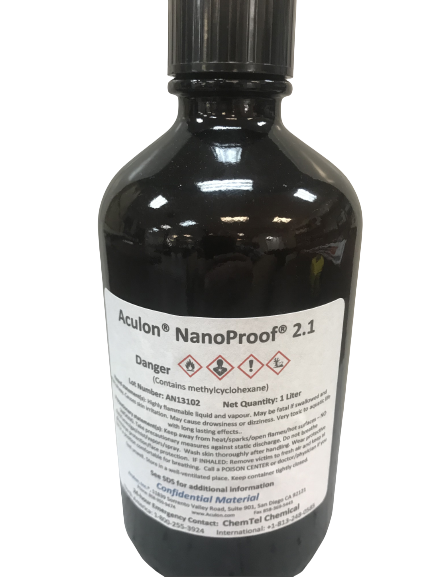NanoProof 2.1 PCB Waterproofing Surface Treatment
- Hydrophobic treatment
- 30-50 μm thickness
- IPX7, IPX8
Product Description
NanoProof 2.1 is a surface treatment designed to impart hydrophobicity and reduced friction to circuit boards and electronic components. It is a simple, one-step process that provides a basic protective film for liquids.
NanoProof 2.1 is a PFAS free, easy to use, and the dried film is nonconductive. The treatment can adhere to a broad range of substrates and contains a UV tracer. This product also requires no cure and can be applied through various methods including dispense and dip.
Advantages of Aculon's NanoProof 2.1
- More forgiving during application
- 30-50 μm thickness
- No cure required
- Deformable (gel like) coating so needs to be handled with care
- Contains UV tracer
- RoHS and REACH compliant
- PFAS Free
Utilization of multiple options
Please note that many customers have found significant success utilizing two or more of the available NanoProof® technologies successfully. Often times the most sensitive components benefit from the most robust NanoProof® technology (5.1) while the remaining components can be coated with the less robust coatings to benefit from their electrical push-through capability, flexible nature, and lower costs!
Detection/Inspection
All NanoProof products contain a UV Tracer which is visible under 365nm wavelength UV light (Detectable by both the human eye and automated detection systems). Please note that soldermasks and other substrate materials containing a UV tracer may make accurate detection of NanoProof difficult.
Technical Specifications
| General Properties | |
| Color Color The color | Clear |
| Solids | 20 % |
| Specific Gravity Specific Gravity Specific gravity (SG) is the ratio of the density of a substance to the density of a reference substance; equivalently, it is the ratio of the mass of a substance to the mass of a reference substance for the same given volume. For liquids, the reference substance is almost always water (1), while for gases, it is air (1.18) at room temperature. Specific gravity is unitless. | 0.79 |
| Total Thickness Total Thickness Total thickness is taking into account all the films, coatings, adhesives, release liners and special layers and is the maximum thickness of a film or tape. | 30-50 μm |
| Thermal Properties | |
| Boiling Point Boiling Point The amount of degree’s needed to reach in order to make the substance boil. | 101 °C |
| Flash Point Flash Point The flashpoint of a solvent is the lowest possible temperature at which it can vaporize to form an ignitable vapor. Flashpoint is often confused with “autoignition temperature”, which is the temperature at which a solvent ignites without an ignition source. | -4 °C |
| Electrical Properties | |
| Volume Resistivity Volume Resistivity Volume resistivity, also called volume resistance, bulk resistance or bulk resistivity is a thickness dependent measurement of the resistivity of a material perpendicular to the plane of the surface. | 1.93 *10^12 Ohms⋅cm |
| Physical Properties | |
| Viscosity Viscosity Viscosity is a measurement of a fluid’s resistance to flow. Viscosity is commonly measured in centiPoise (cP). One cP is defined as the viscosity of water and all other viscosities are derived from this base. MPa is another common unit with a 1:1 conversion to cP. A product like honey would have a much higher viscosity -around 10,000 cPs- compared to water. As a result, honey would flow much slower out of a tipped glass than water would. The viscosity of a material can be decreased with an increase in temperature in order to better suit an application | 5000 mPa.s |
Additional Information
How to apply NanoProof 2.1
STEP 1 ⇨ CLEAN | STEP 2 ⇨ TREAT | STEP 3 ⇨ DRY |
| Parts must be sufficiently clean before treatment for proper bonding and effective application. This can be accomplished by first degreasing the surface with solvents/rinsing with IPA. | Dip - Fully immerse the part in the treatment solution and withdraw at 1-5 mm/second (faster withdraw rate increases coating thickness). |
To dry, the part should be placed at room temperature until the solvent is evaporated. Depending on thickness, parts should be fully cured in 60 minutes.
|
Dispense - Dispense the treatment over the surface, applying enough to coat the entire surface. Allow excess material to drain. |
Application Tips
- In some cases, Kyzen cleaners like Ionox I3s416 or Cybersolv 141-R may be appropriate for removing surface contamination.
- For dip applications, dip containers should be stainless steel, glass, or aluminum. Plastic containers are likely to contaminate the solution.
- Use a microfiber cloth to wipe after cleaning.
- Coat the substrate as soon as possible after cleaning to prevent recontamination.
- Cure temperatures and conditions should be optimized based on substrate and durability requirements.
- Expect no mask to be compatible
- Methylcyclohexane can be used as a diluent
| Recommendation for tubing and plastics via application equipment | ||
| Compatible with: | SS Nozzles/Dispensers, Polyethylene terephthalate (PET), Polytetrafluoroethylene (PTFE), | |
| Incompatible with: | HDPE, LDPE, Polyurethane, PVC, Tygon, Noryl, ABS, PP, Polyphenol ethylene ether, silicone, neoprene, EPM, and natural rubber | |



